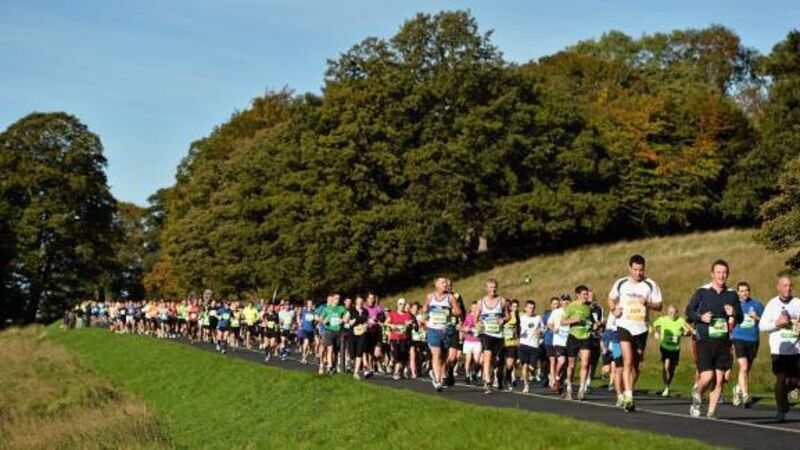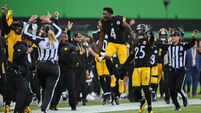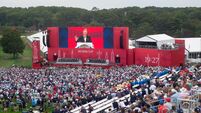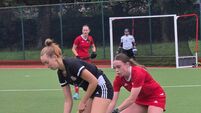In the early stages of a marathon, even flying seems a possibility

It’s six and a half years since I’ve run a marathon and I ache for it something rotten. The past few years have hobbled me with various injuries, and each time I think I’m ready to retrain, another part of my body suffers a mischief.
A month before the 2009 Dublin Marathon, I broke my toe in a fall while I was running to answer the phone. I sat out that race and entered the Valencia Marathon in Spain the following February. In the 23rd mile of that marathon, however, my left knee went from under me. I ran through the pain because I needed a finishing time in order to qualify for an ultra-marathon that summer. My brimful bladder provided a distraction from the knee pain; I discovered later I had been asking my Spanish co-runners where the beer (cerveza) was instead of the toilet (servicio), and couldn’t figure out why they just laughed and ran on.
I finished the race in 3 hours, 59 minutes, 59 seconds. An MRI later revealed I had torn the meniscus in my knee, which required surgery. The surgeon said he didn’t like the crunching of my good knee either and that it would also need an operation someday. Crunching is good in biscuits but not in knees, apparently.
I began running aged 12 when I went to secondary school. I’d spurt-grown to my full height by then and was gawky and awkward so any sport involving a ball, racquet, or stick wasn’t advisable. I preferred cross-country to track because the distances were longer and there were fewer tactics.
I just wanted to run and not worry about the quick little sums I should be doing in my head to calculate my lap times, or my competitors’ lap times. When I was 17, I decided to run my first marathon. I disliked the stifling nervous energy of shorter races, and felt no great competitive urges towards my rivals. I wanted to do something that would pit myself against myself alone. To run the Dublin Marathon in 1996, athletes were supposed to be 18 or over, but 17-year-olds were allowed to enter if they had a signed letter from a parent. My mother wrote the letter as if she was signing my death warrant, probably wishing I would just get drunk or high like a normal teenager.
In the early stages of that marathon, and every marathon since, running felt so effortless the possibility of flying didn’t seem unreasonable, but reality eventually hit in the form of the dreaded Wall. Somewhere around mile 22, I lose all interest in the race, in carrying on, in life. You know it’s just your glycogen reserves running low, but that’s no help when your body wants to curl up in a foetal position on the side of the road and weep.
This, to me, is the essence of the marathon: more than a physical challenge, completing the 26.2 miles is a feat of defiance against that voice in your head that says Quit. For some daft reason I can’t recall, I ran that first marathon without socks. By the finish, my heels were stripped bare of skin and the backs of my runners were red with blood.
I still have lumpy heels today. The toenails of my big toes turned black, which happened in every subsequent marathon: They either grow out or get tangled in a duvet-thread and are ripped out.
In my warped runner’s vanity, these black shells are items of beauty, proof of a race hardily run. Over the next decade, I ran two more marathons, shedding more toenails, increasing my blister count, and reducing my finish-time. Gradually running became popular - in 1996, around 2,700 people completed the Dublin Marathon; in 2016, 19,500 have entered. For once I’d been ahead of the zeitgeist.
After a few marathons, however, the need for something longer kicked in. I felt I couldn’t increase my speed without dramatically overhauling my diet, which I wasn’t committed to doing. Also, shaving minutes off my personal best would mean concentrating on GPS gadgets for measuring time and speed, which takes the good out of running for me.
Technology and I are not friends; I had run one marathon with a cheap children’s wristwatch that stopped halfway through, so I just followed my legs instead. I decided to run the 2010 Comrades Ultra-Marathon in South Africa, a 56-mile race between Durban and Pietermaritzburg that must be completed in under 12 hours.
In a niche sport that’s built on pain, Comrades seems particularly masochistic. The race director counts down the final minute, and participants who cross the line after 12 hours get a DNF (Did Not Finish) beside their name and an X on their race numbers. I’ve watched the finish on YouTube; the contrast between the elation of those who run 11:59:59 and the deflation of those who finish a second later is sobering, but it’s that arbitrariness that’s also appealing. How can one second mean the difference between success and failure?
Unfortunately, however, my banjaxed knee also meant a banjaxed ultramarathon dream. Around the time I was supposed to have been running Comrades, I was undergoing knee surgery. Before the operation, the surgeon said the scarring would be minimal, but I didn’t care if they did a slash-botch Frankenstein job; all I wanted to know was whether there were ultramarathons in my future.
he surgeon couldn’t make any promises. When I came round after the operation, I had a half-drugged daydream in which I was running along a flat, straight, endless road through a desert, the kind of road you see in American movies. I was above myself looking down, my arms and legs flowing so perfectly it looked like I was swimming on waterless land.
I insisted to the nurses it was an epiphany, but it was probably just a scene from Forrest Gump replaying in my head. Around the time I got injured, the world and its mother and grandmother seemed to take up running. I became a cheerleader for friends and family who were running marathons: if I couldn’t use my legs in the actual race, I could certainly use my lungs on the sidelines. Not being able to run was a physical torment, however. Running is freedom to me, it’s forgetting, it’s everything as it should be: limbs in motion, mind at rest, no mulling just doing, which is good for someone like me who reads too much and thinks too much. The sense of freedom I get from running is one I get from sea-swimming when I doggy-paddle far out of depth, straight for the horizon. The pleasure of running is in the open road, the pleasure of swimming in the open sea. Laps of a track or a pool don’t quite cut it for me, I feel like a deranged hamster on a wheel.
I’m reluctant to take up non-running sports. The sports I’m drawn to require good balance and strong knees - kickboxing, hurling, karate – and my core is particularly rotten. I don’t cycle because my physical sense of my body in space is faulty. Like a bat with wonky sonar, I have no sense of where the handlebars stop and the parked car begins, and I tend not to notice details like kerbs and potholes, with the same horizontal result for me.
I tried yoga, but I felt hemmed in on all sides by my classmates grimly focused on finding their centre, and I emerged more stressed than I was before. I eventually settled on gym training to reduce impact on my crackling joints, despite my aversion to walled-in exercise.
After several physio sessions, it became clear returning to serious long- distance running wasn’t a possibility. I needed a new obsession, and I landed on writing. I had loved writing as a child but was out of the habit. Joining a writing class brought me back to concocting stories, and gave me the confidence to write my first novel, Eggshells. Training for marathons helped greatly with novel-writing. Both involve fighting the instinct to lie on the sofa watching telly, both involve small frequent amounts of effort instead of large sporadic chunks, both involve lots of sugar and caffeine, teeth- gritting and cursing.
Last year, a friend who had taken up running to stave off the beer-paunch decided to run his first marathon. I was doing some gym-work combined with small amounts of jogging. We decided to jog the Dublin Marathon together, my friend’s novice uncertainty nicely matched to my post-injury plodding. One morning that summer, I went for a run along the cliffs in Kilkee. Conditions were perfect – the sun was watery, the air was still, the waves were doing their thing on the rocks below - I thought I might just be the luckiest person in the world. Pride literally comes before a fall, however. I missed my footing, fell into a ditch, felt an almighty throb of pain in my ankle.
There are potentially worse outcomes than torn ligaments when you take a tumble at a cliff edge, but I wasn’t feeling quite so grateful at the time. Another round of hospital visits and X-Rays and physio followed; I was out of action for a year. But I’m back running again now: slowly, gingerly, bulkily, with a knee support and an ankle support. It’s hard to find your form after so much time out (and cake), but the joy of seeing the world at jogging-pace is immense. When I feel trapped in a gym machine cycle,
I strap up my dodgy joints and hit the road, in blissful sweaty solitude. I don’t risk running too often but who knows what my athletic future holds. If I get a pair of new knees or if medical advances mean that artificial cartilage can be injected into decrepit old knees, I may get to run an ultramarathon in my nineties. And that would be worth anything.





